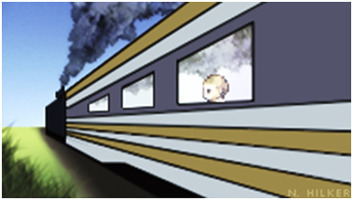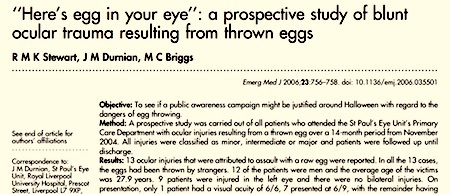Marc Abrahams's Blog, page 228
February 15, 2017
Triskaidekaphobia When People Buy a House (podcast 102)
IN THIS EPISODE: Does a house fall in value if its street address includes the “unlucky” number 13? A research study explores that very question, and we explore that study, in this week’s Improbable Research podcast.
This week, Marc Abrahams discusses a published triskaidekophobia study. Physicist Melissa Franklin lends her voice, and her scientific expertise, and her opinions —with dramatic readings from a research study you may have overlooked.
For more info about what we discuss this week, go explore:
“Triskaidekaphobia and North American Residential Real Estate Prices,” James E. Larsen, International Real Estate Review, vol. 18, no. 3, 2015, pp. 317-329.
The mysterious John Schedler or the shadowy Bruce Petschek perhaps did the sound engineering this week.
The Improbable Research podcast is all about research that makes people LAUGH, then THINK — real research, about anything and everything, from everywhere —research that may be good or bad, important or trivial, valuable or worthless.
*** As mentioned above, THIS episode is the FINAL episode we are doing with CBS. We want to thank CBS, and in particular, Greg Herman, for the two happy years we’ve worked together.
We’ll have details soon about our new broadcast home for this podcast. We expect everything will be up and running, with new episodes, a few weeks from now. IF the technology cooperates, your podcast subscription will transfer automatically, and you won’t have to do anything to keep getting new Improbable Research podcast episodes automatically. But technology has its mischievous side, and one never knows when it will do something unexpected, or fail to do anything at all. That’s the magic of technology. (You will always be able to find the podcast right here at Improbable.com, of course!) ***

February 14, 2017
Centrifugal duration: An almost sure-fire way to lose weight (and other things)
If someone put you in a centrifuge — for an entire year — would you lose weight?

An essay by someone named Sarah argues, that “Centrifugation makes animals smaller, leaner, more muscular, and denser-boned.” The essay gives many examples. Here are two of those examples:
Female rats exposed to 3.5 or 4.7 G for one year showed “marked depletion of body-fat depots” and “significant decrease in kidney and liver lipids.”[2]…
The drop in body fat from centrifugation can be quite large; chickens went from 13% body fat to 3% body fat at 3G, and mice have a 55% drop in total body fat after 8 weeks of 2G exposure.[18]
Here are the studies that produced those, uh, results:
[2] Oyama, J., and B. Zeitman. “Tissue composition of rats exposed to chronic centrifugation.” American Journal of Physiology–Legacy Content 213.5 (1967): 1305-1310.
[18]Fuller, Patrick M., et al. “Neurovestibular modulation of circadian and homeostatic regulation: vestibulohypothalamic connection?.” Proceedings of the National Academy of Sciences 99.24 (2002): 15723-15728.
A question raised, but not stated, by these studies: If you rode in a centrifuge for a year, or even for eight weeks, would you inevitably lose not just weight, but also all hope? Would a rat, or a chicken?

February 13, 2017
Achievements in pepper spicelessness: First the jalapeno, now the habanero
Eighteen years after the creator of the spiceless jalapeno pepper was awarded an Ig Nobel Prize, a different plant-breeding scientist has achieved spicelessness in a different variety of chile pepper, say reports.
Dr. Paul Bosland, director of The Chile Pepper Institute at New Mexico State University, was awarded the 1999 Ig Nobel biology prize for breeding a spiceless jalapeno chile pepper.
Today, in 2017, NPR’s “The Salt” blog reports about the new, second-spiceless-pepper, achievement:
This Heatless Habanero Packs All Of The Flavor With None Of The Burn
[A] pepper — an aromatic, orange habanero without any heat…
“We selected the habanero for heat because that’s what was coveted. But what if you wanted to experience the melon-like experience of a pepper?” Barber asks. “You can’t do it with a habanero — you can with a Habanada.”
Cornell plant breeder Michael Mazourek created the Habanada as part of his doctoral research. He got the idea after discovering a rogue heatless pepper whose genetics behaved very differently from a naturally sweet pepper like the Bell.
The man behind the Habanada is a Cornell University plant breeder named Michael Mazourek, who created it as part of his doctoral research….

Future fashion cycles of Korean pants – a study
Is it possible to establish a fashion theory frame to forecast future fashion cycles of pants (in the Republic of Korea) – through analyzing past fashion cycles of pants through a diachronic method? Yes! says researcher Seonsook Kim of the Dept. of Clothing & Textiles, Daejeon University, Republic of Korea. A paper on the subject is published in the Journal of the Korean Society of Clothing and Textiles Vol. 37, No. 6 (2013) p.786~798, and is entitled:
‘The Analysis of Pant Style Trend to Establish a Fashion Cycle Theory: Focus on 1967 to 2012’ (note: mostly in Korean).
“
This study establishes a fashion theory frame to forecast future fashion cycles of pants through analyzing past fashion cycles of pants through a diachronic method. Pants pictures from 1967-2012, post-industrialized period of Korea were analyzed. Representative pant styles, fashion cycles of pants and the relation of pant styles, length and width were identified. The total of 1006 pictures in fashion magazine published over 46 years were selected and analyzed using PASW 18.0 (statistical program).
The results are as follows. For 46 years, representative pant styles were skinny, regular and bell-bottom. The first cycle period was from 1969 to 1992 and lasted 24 years. The second cycle period was from 1993 to 2003 and lasted 11 years. The third cycle is ongoing as of 2004. Fashion cycles have shown a general trend to be shortened. The relation between pant styles, length and width revealed related results; in addition, pant length and width changed significantly in a similar orientation. Fashion marketers can develop successful products using fashion cycle theory from these results.”
Note: It remains unclear as to whether pant lengths and styles can be meaningfully related to economic trends.

February 12, 2017
The dismaying danger of buying perfume as a gift
Craig Roberts, at the University of Stirling, warns you, based on his research, that there are “more reason to choose fragrances carefully“:
there is no one-scent-fits-all effect here. Different fragrances suit different people. In a study with my Czech colleague [Ig Nobel Prize winner] Jan Havlíček, we found that some people get this spectacularly wrong. While overall artificial fragrances improve the smell of their natural body odour, for some people, their armpit odour smells worse when they use their chosen fragrance – they have selected one that clearly doesn’t blend well with their own odour. More recently, my excellent ex-student Caroline Allen has shown that the right fragrance choice can emphasise the distinctiveness of our underlying body odour.
Now, Caroline has found something really very interesting about the effects of fragrances. Whereas the smell of unperfumed armpits (relatively masculine or feminine) predicts how our faces look (relatively masculine or feminine), this relationship disappears when men use fragrance. The relationship is maintained in the case of women’s smell and faces. And it disappears, in men, in an interesting way

DNA Cologne, invented by Bijan of Beverly Hills. The inventor was awarded the 1995 Ig Nobel Prize for chemistry.
In a recent Improbable Research podcast, Jean Berko Gleason explores the Roberts/Havlíček team’s garlic/armpit-smell study, with glee and more than a soupçon of disgust.

February 11, 2017
The Likely Obscurity of Famous Psychologists
“The most famous psychologists today will be forgotten in less than a century”, says this study:
“Varieties of Fame in Psychology,” Henry L. Roediger III, Perspectives on Psychological Science, vol. 11, no. 6, November 2016, pp. 882-887. The author, at Washington University, St. Louis, explains:
“Fame in psychology, as in all arenas, is a local phenomenon. Psychologists (and probably academics in all fields) often first become well known for studying a subfield of an area (say, the study of attention in cognitive psychology, or even certain tasks used to study attention). Later, the researcher may become famous within cognitive psychology. In a few cases, researchers break out of a discipline to become famous across psychology and (more rarely still) even outside the confines of academe. The progression is slow and uneven. Fame is also temporally constricted. The most famous psychologists today will be forgotten in less than a century, just as the greats from the era of World War I are rarely read or remembered today. Freud and a few others represent exceptions to the rule, but generally fame is fleeting and each generation seems to dispense with the lessons learned by previous ones to claim their place in the sun.”
Here’s further detail from the study:

(Thanks to Christian Jarrett for bringing this to our attention.)
BONUS QUESTION: How famous is Henry L. Roediger III?
BONUS: “Should this essay about fame become famous?”
BONUS: “MEASURING FAME QUANTITATIVELY. V. WHO’S THE MOST FAMOUS
OF THEM ALL? (PART 2)”

February 10, 2017
Bernard Vonnegut, Ice-17, Ice-9, chicken-plucking, and tornadoes
Bernard Vonnegut, that most surprising atmospheric scientist, gets appreciated in an Italian-language essay called “Ice Numbers“, by Franco Bagnoli of the University of Florence, published in Ciencia y Cultura. Here’s a machine translation of bits of Bagnoli’s essay:
At the end of 2016, at the Institute of Complex Systems of the CNR in Florence, Italy, a new solid phase of water was discovered: ice XVII….
The news, and the discussion workshops that followed, reminded me of one of my favorite novels by writer Kurt Vonnegut [which involves a new phase of water, called “ice-nine”]… Who could have given Vonnegut the idea of this new phase of water? Probably his brother. Bernard Vonnegut, who was a scientist of the atmosphere. He discovered that silver iodide can be used as a nucleating agent to induce rainfall. In the clouds, the water is in the form of small supercooled drops….
Bernard Vonnegut became famous in 1997, the year of his death, for having won the Ig Nobel Prize in meteorology for a 1975 article entitled “Chicken Plucking as Measure of Tornado Wind Speed“.


Diesel Trains May Expose Passengers to Exhaust [research study]
Passenger trains train a rain of exhaust on the passengers, if the trains burn diesel fuel and the passenger cars traipse dutifully behind the exhausting locomotive. Details are in this possibly-not-entirely-surprising study:
“Exposure to ultrafine particles and black carbon in diesel-powered commuter trains,” Cheol-Heon Jeong, Alison Traub, Greg J. Evans, Atmospheric Environment, epub February 8, 2017. (Thanks to Falk Fish for bringing this to our attention.) The authors, at the University of Toronto, report:
“Ultrafine particle (UFP), black carbon (BC) and lung deposited surface area (LDSA) concentrations measured during 42 trips on diesel-powered commuter trains revealed elevated exposures under some conditions. When the passenger coaches were pulled by a locomotive, the geometric mean concentrations [were] higher than the exposure levels when the locomotive pushed the coaches.”
This drawing is part of the published study:
BONUS: Here are action videos of diesel-powered commuter trains:

February 9, 2017
The Hemline and The Economy – examining an urban legend
“Urban legend has it that the hemline is correlated with the economy. In times of decline, the hemline moves towards the floor (decreases), and when the economy is booming, skirts get shorter and the hemline increases.”
 To test the validity of such a(n) hypothesis, researchers Marjolein van Baardwijk and Full Professor Ph.H.B.F. (Philip Hans) Franses of the Econometric Institute at the Erasmus School of Economics, Rotterdam, The Netherlands, conducted a research project – reporting that :
To test the validity of such a(n) hypothesis, researchers Marjolein van Baardwijk and Full Professor Ph.H.B.F. (Philip Hans) Franses of the Econometric Institute at the Erasmus School of Economics, Rotterdam, The Netherlands, conducted a research project – reporting that :
“Based on the analysis of actual data on the hemline, which goes back to January 1921, we found that the economic cycle leads the hemline with about three years. Supporting the urban legend, we find that poor economic times make the hemlines to decrease, which means that women’s dresses get lower, and that prosperity is correlated with a reduced hemline (more miniskirts). At the same time, and this is new to the available evidence, we find that there is a time lag of around three years. This explains why at present, in an economic downturn, the skirts are short, as this is simply due to the fact that the economy was in a boom about three years ago (2007-2008).”
see: The hemline and the economy: is there any match? Econometric Institute Report, 2010-40.
BONUS The Evolution of the Skirt (author: Harry Julius [1885–1938]) – an animation from 1916 – from which the still above is taken.
Coming soon – Korean cyclical pant lengths.

February 8, 2017
Egg in Your Eye (podcast 101)
Can the public focus on the medical dangers of egg-throwing at Halloween? A research study explores that very question, and we explore that study, in this week’s Improbable Research podcast.
SUBSCRIBE on Play.it, iTunes, or Spotify to get a new episode every week, free.
This week, Marc Abrahams discusses a published egg-in-your-eye study. Psychologist Jean Berko Gleason lends her voice, and her scientific expertise, and her opinions —with dramatic readings from a research study you may have overlooked.
For more info about what we discuss this week, go explore:
” ‘Here’s Egg in Your Eye’: A Prospective Study of Blunt Ocular Trauma Resulting from Thrown Eggs,” R.M.K. Stewart, J.M. Durnian, and M. C. Briggs, of Liverpool University Hospital, published in Emergency Medical Journal, vol. 23, 2006, pp. 756-8.
The mysterious John Schedler or the shadowy Bruce Petschek perhaps did the sound engineering this week.
The Improbable Research podcast is all about research that makes people LAUGH, then THINK — real research, about anything and everything, from everywhere —research that may be good or bad, important or trivial, valuable or worthless. CBS distributes it, on the CBS Play.it web site, and on iTunes and Spotify).

Marc Abrahams's Blog
- Marc Abrahams's profile
- 14 followers








